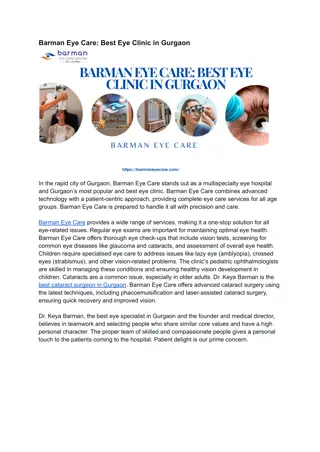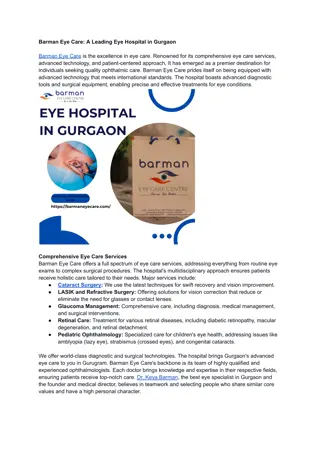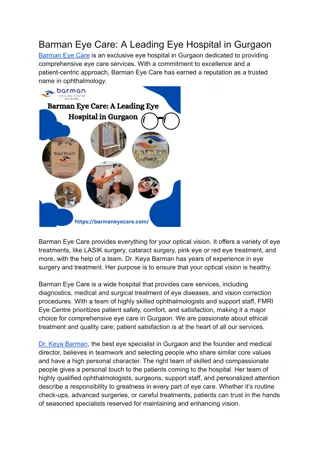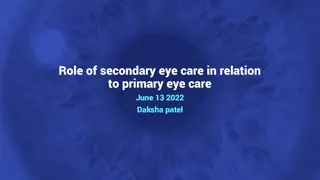Successes of Eye Health Care Delivery Plan in Wales
The Eye Health Care Delivery Plan in Wales, led by Fiona Jenkins, has shown significant successes from 2013 to 2020. Key outcomes include a notable increase in the number of people receiving regular sight tests, successful eye health awareness campaigns, improved accessibility to extended eye care services, and heightened awareness of the importance of eye health among the population. These outcomes have positively impacted the delivery of eye care services in Wales.
Download Presentation

Please find below an Image/Link to download the presentation.
The content on the website is provided AS IS for your information and personal use only. It may not be sold, licensed, or shared on other websites without obtaining consent from the author.If you encounter any issues during the download, it is possible that the publisher has removed the file from their server.
You are allowed to download the files provided on this website for personal or commercial use, subject to the condition that they are used lawfully. All files are the property of their respective owners.
The content on the website is provided AS IS for your information and personal use only. It may not be sold, licensed, or shared on other websites without obtaining consent from the author.
E N D
Presentation Transcript
Successes of the Eye Health Care Delivery Plan for Wales Fiona Jenkins Chair Wales Eye Care Steering Board
POLICY AND STRATEGY Eye health care delivery plan 2013 to 2020 Merged the early recommendations with the later priorities: 19 key outcome areas
Outcome 1: Outcome Evidence Stats Bulletin 2013/14 758,572 General Ophthalmic Services (GOS) sight tests were carried out on the NHS, 7237 Total LVSW Assessments Carried out, 96,487 EHEW assessments carried out in Wales. Total number: 862,296 More People have regular sight tests 2018/19 795,188 (GOS) sight tests were carried out on the NHS, 9183 Total LVSW Assessments Carried Out, 169,920 EHEW assessments Carried out in Wales. Total number: 974,291 Increase of 111,995
Outcome 2: Outcome Evidence Communications Group Eye campaigns Acute eye campaign - 2015 Choose Well Campaign 2015 BME Campaign 2015 Public Health Wales Campaigns during 2015-2016 AMD Campaign 2017 Deprived areas campaign Diabetes Campaign 2016 Low Vision Over 60 s Smokers 2014 GP One Website 2015 Local health board initiatives. More information on reducing the risk of developing eye disease, what people can do for themselves and what services to expect to be available
Outcome 3: Outcome Evidence National Survey for Wales 2014/15 72% of respondents had their eyes tested at least once every two years. 57% of people aged 25 to 44 had their eyes tested at least once every two years, compared with 91% of people aged 75 or over More people aware of the importance of eye health 2018/19 73 % of respondents had their eyes tested at least once every two years. 59% of people aged 25 to 44 had their eyes tested at least once every two years, compared with 91 % of people aged 75 or over.
Outcome 4: Outcome More optometry practices providing the full range of extended eye care services in the community Evidence 2013/14 187 Accredited LVSW Practices in Wales 295 Accredited EHEW Practices in Wales 2017/18 - 210 Accredited LVSW Practices in Wales 348 Accredited EHEW practices in Wales
Outcome 5: Outcome Evidence Sensory Health: Eye Care and Hearing Statistics More people aware of the most appropriate point to access eye care if they have an eye problem that needs urgent attention 2015 All respondents were asked who they would contact in the first instance if they had any pain or redness in their eye. 60% said they would contact their GP and 34% their optician 2019 All respondents were asked who they would contact in the first instance if they had any pain or redness in their eye. 47 per cent said they would contact their GP and 40 per cent their optician.
Outcome 5: Outcome Evidence More people aware of the most appropriate point to access eye care if they have an eye problem that needs urgent attention Evidence General Optical Council Public Perceptions Survey 26 per cent of Welsh would first visit an optician if they woke up with an eye problem compared to just 18 per cent in England.
Outcome 6: Outcome Evidence Eye Health Examination Wales annual report March 2018 produced an audit looking at access to services. Overview: Mean age of patients accessing EHEW services- 56.4 Mean travel time for patients accessing EHEW services- 10.6 minutes Mean travel distance for patients accessing EHEW services- 5.2 miles Reduced Inequalities in access to optometry services
Outcome 6: Outcome Evidence Reduced Inequalities in access to optometry services Summary of results Most patients in Wales travel short distances to access the EHEW service, with travel times averaging 10 minutes. Additionally, patients from different socio-economic and ethnic backgrounds also access the service in large numbers demonstrating that the service is well used by different patient demographics. Travel times and distances were not substantially different for different socio- economic and ethnic groups. The EHEW service succeeds in its aim of service all populations in Wales with excellent equity of access.
Outcome 7: Outcome Evidence Diabetic eye screening Wales is the only life-long UK screening programme. All people aged 12 and over with a diagnosis of diabetes, who are registered with a GP in Wales, are eligible for regular retinal screening with DESW. 2012/13- 168,551 patients registered and 111,110 patients screened. 2017/18- 174,240 patients registered and 114,309 patients screened. More people at high risk of eye disease accessing eye care services in the community including people with diabetes, family history of glaucoma and people from ethnic minority groups
Outcome 7: Outcome Evidence EHEW Collected Figures: More people at high risk of eye disease accessing eye care services in the community including people with diabetes, family history of glaucoma and people from ethnic minority groups 2014: 4383 members of BME groups accessed EHEW services 2017/18: 8093 members of BME groups accessed EHEW services
Outcome 7: Outcome Evidence Sensory Health: Eye Care and Hearing Statistics 2012-13: Close relatives aged 40 and over of glaucoma sufferers 38,708 GOS sight tests performed. 2018-19: Close relatives aged 40 and over of glaucoma sufferers 39,610 GOS sight tests performed. More people at high risk of eye disease accessing eye care services in the community including people with diabetes, family history of glaucoma and people from ethnic minority groups EHEW Band 2 examinations for patients who are suspected of having eye disease receive additional examinations, including those suspected of having glaucoma.
Outcome 8: Outcome Evidence Not a specific measure captured on this, but statistics are produced regarding the number of domiciliary GOS sight tests and now Low Vision domiciliary examinations which do provide some information. More People in residential care having regular sight tests. 2012-13: 24,139 GOS domiciliary sight tests. No information regarding Low Vision 2018/19: 27,663 GOS domiciliary sight tests provided and 2663 Low Vision domiciliary examinations.
Outcome 9: Outcome Evidence School pupil eye care service (SPECS) Pupils who attend school who are unable to access the current Children s Vision, 9,358 pupils attended a special school or a special unit within a mainstream school across Wales More children in special schools having sight tests in school The commissioned SPECS project was signed off by HDUHB executive team and submitted to Welsh Government 1st May 2019.
Outcome 10: Outcome Evidence More children having their vision screened upon school entry School vision screening programmes in place with referral to optometrists for children who fail screening.
Outcome 11: Outcome Evidence Linked to outcome 1 which showed the increase in the number of examinations being performed under EHEW and LVSW. People are seen within the primary and community setting, where its clinically appropriate. Increase referrals to EHEW services across Wales, ( 6/7 LHS show increased referrals) Increased EHEW practices Pathways in place to increase referrals further
Outcome 12: Outcome Evidence National programme being led by Wales Ophthalmic Planned Care Board. Additional funding allocated to increase capacity Outcome focussed measures in place Electronic patient record being procured to enable greater efficiency/effectiveness of pathways People receive appropriate access to on-going care and management of their eye condition.
Outcome 12: Outcome Evidence People receive appropriate access to on- going care and management of their eye condition. Positive signs of transformation: The number of glaucoma patients discharged for management in the community varies across health boards. Aneurin Bevan University Health Board is the lead health board who were actively using community facilities to deliver its glaucoma service. This had resulted in around 70% of their glaucoma patients being seen by a non-medic, which has significantly reduced capacity requirement in hospital sites.
Outcome 12: Outcome Evidence People receive appropriate access to on- going care and management of their eye condition. Positive signs of transformation: A modelling exercise undertaken by the NPCP across this pathway, identified that around 3,500 non-complex glaucoma patients could be followed up in an Ophthalmic Diagnostic and Treatment Centre (ODTC) / community setting. In 2016, 15,000 patients were managed in this way. There are now clear indications that progress is now being made at pace. In 2018 there were 22,000 patients being seen in an ODTC setting, which the expectation this will increase further in 2019.
Outcome 12: Outcome Evidence People receive appropriate access to on- going care and management of their eye condition. Positive signs of transformation: The NPCP has agreed that 80% of post- operative follow-up for cataract element of patients care at 1 month are carried out in primary care. Aneurin Bevan, Abertawe Bro Morgannwg, Powys and Hywel Dda all report that 95% of non- complicated patients are now routinely being referred to Optometrists following surgery without a need for an additional hospital assessment. However, hospital based post-operative follow up is still being practiced in some health boards.
Outcome 12: Outcome Evidence People receive appropriate access to on- going care and management of their eye condition. Positive signs of transformation: Hywel Dda University Health Board has taken the decision to review referrals for over 600 patients awaiting an OPD appointment on the pathway and move them directly to pre-operative assessment. Review of the success of this initiative will provide a significant evidence base for the wider adoption of this model within Wales.
Outcome 13: Outcome Evidence Service users and carers are involved in the design of services and peoples views on service are sought regularly and acted on to ensure continuous improvement RNIB and community health council provide input to all local eye care groups as the patients voice. Local arrangements for gathering additional input
Outcome 14: Outcome Evidence One example: In Aneurin Bevan UHB 1698 appointments were freed up in hospital eye care clinic in a 4 month period, as glaucoma patients had their follow up appointment by a community optometrist. Patient feedback People are satisfied with the care they receive at their local optometry practice 100% satisfaction from patients that saw the community optometrist 96% said it was easy to book an appointment 98% said the optometrist understood the condition 85% said that the practice was accessible
Outcome 14: Outcome Evidence People are satisfied with the care they receive at their local optometry practice GOC Public Perceptions Survey: Patients satisfaction and confidence levels in opticians remains very high, with 96% of patients indicating that they were fairly or very satisfied with the optician who had carried out their eye test and 94% being satisfied with the overall experience of the opticians. There continues to be a low level of complaints, with a very small percentage of the population (6%) having complained about an experience with an optician.
Outcome 15: Outcome Evidence People are satisfied with the care they receive when they visit the hospital eye service Yes, largely very happy with clinical care, when they get there, BUT waiting time for first and follow up appointments remains the biggest concern
Outcome 16: Outcome Evidence The only way we can get these facts is by asking people. People are satisfied with the care they receive from social services The Wales Vision Forum collected and continues to collect case studies. We could also ask local groups about what they thought about the support they have received but this would take time. What do you think?
Outcome 17: Outcome Evidence Once a person gets through the system and is seen by a Rehabilitation Officer that these needs are addressed. Concern that some people can easily slip through the net because of lack of understanding of services available to them. Would like to see a standardised assessment being used throughout Wales that captures a person s needs and can be measured to see how successful rehabilitation intervention is. WCB will aim to address if our application under the Sustainable Social Services Third Sector grant (2020-23) is successful. People with sight impairment receive care and support which addresses all their needs both physical and emotional
Outcome 18: Outcome Evidence Local eye care, Hospital eye care and support services are all joined up This is probably the biggest success area. ECLO ROVI Local eye care groups National group LHBs and Welsh Government aligned
Outcome 19: Outcome Evidence This is one of the core competencies of a rehabilitation officer. If people are aware of the service and they have identified this as an outcome. This should be being met. People with sight impairment Are offered specialist training that enables them to live independently and get out and about Members of the Wales Vision Forum and Welsh Rehabilitation Officers Forum have published State of the Nation reports on Rehabilitation and Habilitation, with actions for improvements
Blinding diseases are treated by multi Blinding diseases are treated by multi- - disciplinary teams led by Ophthalmology disciplinary teams led by Ophthalmology wAMD treat & extend + virtual clinic oversight of MDTs OH Chloroquine Screening Programmes virtual clinic oversight of mini-ODTC Minimally invasive glaucoma surgery Selective laser trabeculoplasty biggest change in new glaucoma patient management in a generation Corneal cross linking for keratoconus
Ophthalmology Wales: stuff to sort Ophthalmology Wales: stuff to sort New ways of working o Outreach not outsource Ophthalmology in The Community o How are we going to do all the virtual clinics? o Can we cope with all the electronic queries from Optometry? Delivering required numbers in cataract surgery o Avoidance of costly outsourcing Hub & Spoke reconfigurations o North, South East, South West o Subspecialist care across All Wales via enhanced clinical networks o Sustainable Unscheduled Care, Training & Rotas Consultant workforce o Recruitment & retention o Retirements
What Next? What Next? 14 Green: 2 Green/Amber; 2 to define The plan should be completed by 2020 Planned Care Board will oversee the delivery of performance against national targets Chief Optometric Advisor, will advise!



























